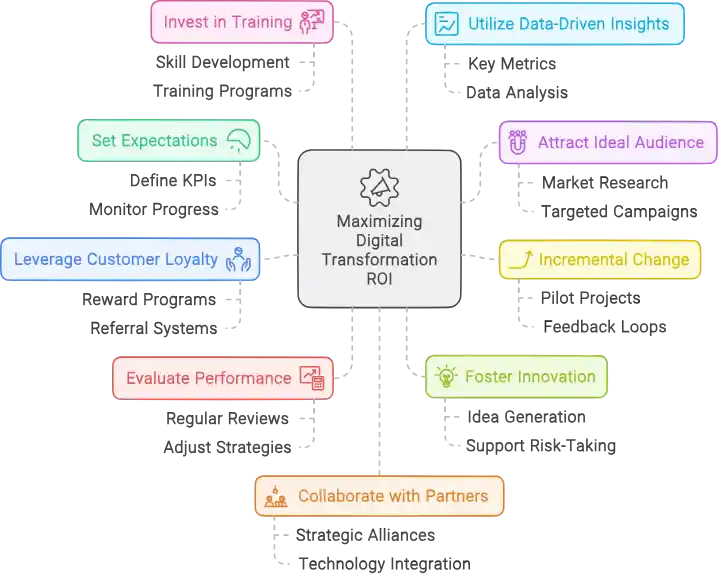ROI of Digital Transformation: 9 Tips to Measure and Improve It
Table of Contents
In today’s fast-paced digital landscape, the importance of digital transformation cannot be overstated. As businesses strive to stay competitive and meet evolving customer expectations, measuring the ROI of digital transformation initiatives has become a critical task. But how can organizations effectively measure and enhance their digital transformation ROI? This detailed guide provides nine practical tips to help you navigate this complex yet crucial aspect of modern business strategy.
Understanding Digital Transformation
Digital transformation involves integrating digital technology into all areas of a business, fundamentally changing how you operate and deliver value to customers. It’s about rethinking old operating models, experimenting more, and becoming more agile in your ability to respond to customers and rivals.
Phases in the Digital Transformation Lifecycle

The lifecycle of digital transformation typically includes the following phases:
- Assessment: Evaluating current processes and identifying areas for improvement.
- Planning: Developing a detailed roadmap and strategy for transformation.
- Execution: Implementing digital technologies and processes.
- Optimization: Continuously refining and improving digital initiatives based on feedback and performance metrics.
Why a Well-Structured Roadmap Is Crucial
A well-structured roadmap serves as a guiding framework for your digital transformation journey. It helps in aligning your business objectives with your transformation efforts, ensuring that every step taken contributes to the overall goals of the organization. Without a clear roadmap, digital initiatives can become disjointed and fail to deliver the expected ROI.
Key Components of a Digital Transformation Roadmap
- Vision and Goals: Clearly define what you aim to achieve with your digital transformation.
- Stakeholder Engagement: Involve key stakeholders to ensure alignment and support.
- Technology Assessment: Identify the technologies that will drive your transformation.
- Implementation Plan: Develop a detailed plan outlining the steps to be taken, resources required, and timelines.
- Metrics and KPIs: Establish metrics and key performance indicators to measure success.
How to Measure the ROI of Digital Transformation
1. Set Business Objectives
Begin by defining clear business objectives. Whether it’s boosting revenue, improving productivity, or enhancing customer satisfaction, having a specific goal will guide your transformation efforts.
2. Define Investment Goals
Outline the financial investments required for your digital transformation, including staffing, infrastructure, and technology costs. Assign specific figures to these investments to create a clear financial picture.
3. Identify Value Metrics
Determine the metrics that will reflect the success or failure of your digital transformation. These could include cost reduction, productivity improvements, or customer satisfaction scores.
4. Determine Time Frames
Set strict time frames for measuring ROI. Establish baseline metrics to understand current performance levels, then set incremental goals to monitor progress within the defined period.
Examples of Key Metrics
- Cost Reduction: Measures the decrease in operational costs due to digital initiatives.
- Productivity Boost: Evaluate the increase in employee productivity.
- Business Growth: Tracks revenue growth and market expansion.
- Data Security: Assesses improvements in protecting organizational and customer data.
- Organizational Culture: Monitors changes in employee engagement and satisfaction.
Tips to Improve the ROI of Digital Transformation Initiatives

1. Set Expectations for Digital Transformation ROI Growth
Establish clear expectations for your digital transformation ROI efforts. This helps in setting a benchmark and guiding the growth and success of your initiatives.
2. Attract the Ideal Target Audience
Focus on acquiring and retaining the right clientele to maximize the impact of your digital transformation. Understanding your target market’s needs will help in designing solutions that enhance customer satisfaction and loyalty.
3. Introduce Change in Smaller Increments
Implementing changes gradually allows your organization to adapt more easily and manage the transformation process effectively. This approach also provides opportunities to refine and optimize new technologies and processes.
4. Leverage Customer Loyalty
Retaining loyal customers is crucial for sustained revenue growth. Focus on enhancing customer experience and engagement to build a strong, loyal customer base. Utilizing loyalty program management software to personalize interactions and tailor offerings can further deepen customer connections and satisfaction.
5. Evaluate Your Performance and ROI Regularly
Continuous performance tracking and regular evaluation of your ROI metrics are essential. This allows you to make informed decisions, adjust strategies, and ensure that your digital transformation initiatives are on track.
6. Foster a Culture of Innovation
Encourage your team to embrace innovation and be open to experimenting with new ideas. A culture of innovation drives continuous improvement and keeps your organization at the forefront of technological advancements.
7. Invest in Employee Training and Development
Ensure that your employees are equipped with the necessary skills to leverage new technologies. Regular training and development programs will enhance their capabilities and contribute to the success of your digital transformation.
8. Utilize Data-Driven Insights
Leverage data analytics to gain insights into your digital transformation efforts. Data-driven decision-making helps in identifying areas for improvement and optimizing your strategies.
9. Collaborate with Technology Partners
Partnering with technology experts and vendors can provide valuable support and expertise. Collaboration can help you implement the best solutions and achieve your transformation goals more efficiently.
Conclusion
Measuring and improving the ROI of digital transformation requires a strategic approach, clear objectives, and continuous evaluation with a proper digital transformation strategy. By following the tips outlined in this guide, you can ensure that your digital transformation initiatives deliver significant returns and drive the growth and success of your organization. Embrace the power of digital transformation and unlock new opportunities for innovation and competitive advantage.
Featured Insights
 Integrating Real-Time Weather Data into Your Travel and Navigation App
Integrating Real-Time Weather Data into Your Travel and Navigation App The Future is Now: AI and ML Technologies Reshaping Healthcare
The Future is Now: AI and ML Technologies Reshaping Healthcare Introduction to Digital Twin Technology in Manufacturing with Unprecedented Efficiency and Innovation
Introduction to Digital Twin Technology in Manufacturing with Unprecedented Efficiency and Innovation Adobe’s Firefly AI: New Tools for Photoshop and Illustrator
Adobe’s Firefly AI: New Tools for Photoshop and Illustrator Introducing Meta Imagine Me: Your Digital Doppelganger
Introducing Meta Imagine Me: Your Digital Doppelganger AI in Gaming is Transforming the Industry
AI in Gaming is Transforming the Industry